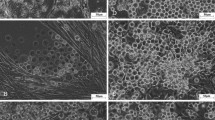Abstract
The susceptibility of third-instar Spodoptera exempta (Walk.) to a heat-treated nuclear polyhedrosis virus was tested in the laboratory. The polyhedral suspension was purified by differential centrifugation and heat-treated at temperatures that ranged from 20 to 90°C for 10–30 min. The LT50 ranged from 108.4 hr for virus heated at 50°C (10 min) to 162.2 hr for virus heated at 80°C (10 min). The fiducial limits to the LD50s were calculated at 0.95 probability.
Similar content being viewed by others
References
Brown E. S. (1970) Control of the African armyworm Spodoptera exempta (Walk.)—an appreciation of the problem. E. Afr. agric.for. J. 35, 237–245.
Brown E. S. and Swaine G. (1965) Virus disease of the African armyworm Spodoptera exempta (Walk.). Bull, ent. Res. 56, 95–116.
Finney D. J. (1971) Probit Analysis. Cambridge University Press, London.
Gudauskas R. T. and Canerday D. (1968) The effect of heat, buffer, salt and H-ion concentration, and ultraviolet light on the infectivity of Heliothis and Trichoplusia nuclear polyhedrosis viruses. J. Invertebr. Pathol. 12, 405–411.
Lathika P. and Jacob A. (1974) Effect of temperature and sunlight on the infectivity of a nuclear polyhedrosis virus of Spodoptera mauritia (Boisduval). Curr. Sci. 43, 587–588.
Macfarlane J. J., Jr. and Keeley L. (1969) Heat effect on the infectivity of the nuclear polyhedrosis virus of Heliothis species. J. econ. Entomol. 62, 925–929.
Martignoni M. E. and Iwai P. J. (1977) Thermal inactivation characteristics of two strains of nucleopolyhedrosis virus (Baculovirus subgroup A) pathogenic for Orgia pseudotsugata. J. Invertebr. Pathol. 30, 255–262.
Nair K. P. V. and Jacob A. (1976) Studies on the nuclear polyhedrosis of Pericallia ricini F. (Lep: Arctidae). Entomon. 1, 23–30.
Pawar V. M. and Ramakrishnan N. (1971) Investigations on the nuclear-polyhedrosis of Prodenia litura F. II. Effect of surface disinfectants temperature and alkali on the virus. Indian J. Entomol. 33, 428–432.
Stuermer J. R. C. W. and Bullock H. R. (1968) Thermal inactivation of Heliothis nuclear polyhedrosis virus. J. Invertebr. Patho. 12, 473–474.
Tanada Y. (1967) Effect of high temperatures on the resistance of insects to infectious diseases. J. Sericult. Sci. Japan. 36, 333–339.
Author information
Authors and Affiliations
Rights and permissions
About this article
Cite this article
Odindo, M.O. Time-Mortality Response in Spodoptera Exempta (Walk.) Infected with Heat-Treated Nuclear Polyhedrosis Virus. Int J Trop Insect Sci 1, 225–230 (1981). https://doi.org/10.1017/S174275840000045X
Received:
Revised:
Published:
Issue Date:
DOI: https://doi.org/10.1017/S174275840000045X




